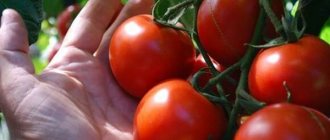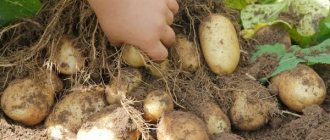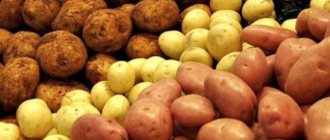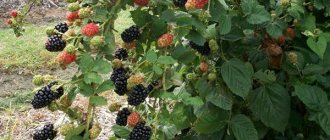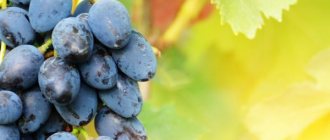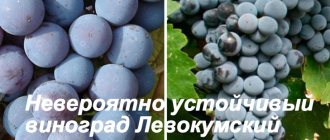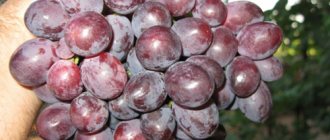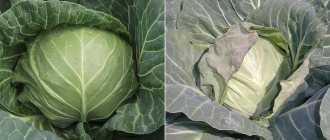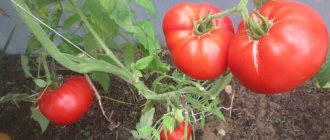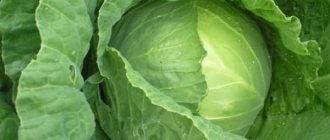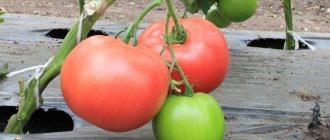History of selection
The Meteor variety was obtained by domestic breeders under the leadership of I.V. Kazakov at the Kokinsky strong point (Bryansk region), operating under the VSTISP. It was obtained by crossing mid-season varieties Novost Kuzmina and Kostinbrodskaya (Bulgaria), which are tall. Their “descendant” turned out to be medium-sized and ripening at a very early stage.
Did you know? 100 g of Meteor raspberries contain about 165 mg of anthocyanins
-
These are flavonoids that give its fruits their red color.
They are beneficial to the human body - they reduce inflammation and are antioxidants that delay aging. State tests of the variety began back in 1979, but it was included in the State Register of the Russian Federation only in 1993. It was zoned into the Northern, Northwestern, Central, Volga-Vyatka, Central Black Earth and Middle Volga regions. It is suitable for industrial production and is grown in amateur gardens.
Description and characteristics
Raspberry bushes of the Meteor variety grow powerful and medium-sized. They have erect shoots up to 2 meters high with a small number of short spines and drooping tops. The surface of the branches is covered with a slight waxy coating. The leaves are rich green in color and consist of 3 or 5 slightly wrinkled plates.
The plant begins to bear fruit on the upper half of the shoots very early - in the first half of June. The red berries grow medium in size - about 3 g. They have a sweet taste and a pleasant raspberry aroma. The pulp has sufficient density and contains up to 10.5% dry matter, 8.2% sugar, about 25 mg of vitamin C and 60 mg of vitamin P.
Learn how to properly grow raspberries in old tires.
In areas with long summers and warm autumns, the variety may show signs of remontancy and produce a small harvest of larger berries on annual shoots. The variety is frost-hardy, resistant to fungal diseases, but susceptible to viral diseases and some pests.
Agrobiological properties
The growth activity of the bushes is significant. Plants can reach a height of 2 m. Their shape is not too spreading, but the tips of the shoots are drooping. The bases of young stems are powerful, erect, greenish in color with a noticeable waxy coating on the surface. The thorns on the shoots are small, rather thin and short. The intensity of their appearance is very weak. This makes it possible to relatively easily tie the stems to the trellis, and then, without much difficulty, harvest from them. Gartering of shoots is mandatory, because... under the weight of the fruit, they bend to the ground, and also run the risk of severe damage in windy weather. It is most convenient to bend annual stems to one side of the trellis, and biennial stems to the other. In the future, this will make it easier to collect raspberries and remove unnecessary vegetative parts of plants after fruiting. Meteor's leaves are complex, consisting of three, rarely five, bright green, medium-wrinkled leaves, located on moderately long petioles without signs of anthocyanin pigmentation. The shape of the leaf blades is oval with a pointed end, the profile is curved downwards. Medium-sized sawtooth teeth are located on the edges of the leaflets. Laterals begin to form approximately from the middle of the shoot, and therefore the fruiting zone is concentrated in the upper half of the stems. Fruit branches are characterized by medium length and degree of branching. They usually bear no more than 10-15 berries. Replacement shoots appear quite actively - about 20-25 pieces per meter. Root suckers heavily clog the row spaces, and fighting them will require considerable effort. But the shortage of planting material for propagation of Meteor definitely does not threaten its owners.
The main fruiting occurs on last year's shoots, and the variety actually opens the season, being one of the earliest ripening. The first berries ripen at the end of June, and the yield of the harvest occurs very smoothly. At the end of the growing season, in the case of a warm, long autumn, plants can demonstrate their partial remontancy, yielding a harvest also based on the current year’s growth. In general, the usual yield of the variety can reach 2 kg of raspberries per bush. In industrial conditions, productivity varies, depending on the climatic conditions of the growing region and the level of agricultural technology, from 50−70 to 100−120 centners per hectare. In terms of yield volumes per unit area, our hero may be inferior to some other forms, however, taking into account the very early period of fruit ripening, he remains out of competition.
The size of the ripened berries of the variety is average, height - 17-17.5 mm, diameter - about 18 mm. Their usual weight ranges from 2.5-3.5 grams, the shape is round-conical, the color is deep red with a noticeable shine on the surface. The drupes are moderately interconnected, due to which they break into fragments only with a certain force. The pulp of the fruit is relatively dense and elastic, has a pleasant dessert taste, and also has a fairly strong aroma typical of the culture. The sugar acid index, which determines the degree of sweetness of the berries, is very high in Meteor, reaching 7.5-8 units. In particular, the total sugar content consistently exceeds 8−9%, while titratable acidity is 1.1−1.3%. Mass fraction of dry substances 10−11%. Anthocyanins are present in 100 grams of fruit in the amount of 160-170 mg, vitamin P - 55-65 mg, and vitamin C - 23-27 mg.
The crop has a variety of uses. First of all, Meteor is eaten fresh with pleasure, which is facilitated by its high tasting ratings. Farmers who grow raspberries for sale are impressed by the variety due to its early ripeness, which allows them to begin selling during periods of high market prices. In addition, an important positive feature for commercial use is the good transportability of the harvested crop, thanks to which the berries reach the shelves without damage or deterioration in marketability. When processed, they also retain their shape well, and the richness of their color makes compotes and jam especially attractive. All preparations for the winter are distinguished by high gastronomic characteristics and a rich mineral and vitamin composition, making them very useful for the body in the winter. An additional option for preserving Meteor fruits fresh is freezing them. After thawing, the berries practically do not lose their shape, taste and aroma.
In cultivation, the variety shows itself well. It does not require excessive care and can grow in various soil and climatic conditions. The bushes are relatively frost-resistant, but they are not particularly drought-resistant, requiring a sufficient level of soil moisture during the growing season. At the same time, excessive dampness, and especially swampiness, is also unacceptable for them. When choosing a site, it is necessary to monitor the groundwater level, because their shallow location can cause rotting of the plant root system. The terrain should provide protection for the raspberry tree from strong winds that can leave the ground without snow cover in winter.
Bushes are planted in well-cultivated and fertilized soil. According to the recommended planting scheme, the distance between rows should be 2-3 m, and between plants in a row 60-70 cm. During the cultivation process, one should take into account Meteor’s increased resistance to common fungal diseases, but low resistance to shoot gall midges, spider mites, overgrowth and purple spot . Based on this specificity, a plant protection strategy should be built.
Advantages and disadvantages
The main feature and advantage of the Meteor variety is the extremely early ripening of the crop.
- This raspberry variety may also be of interest due to the following qualities:
- good frost resistance;
- transportability;
- ease of reproduction;
- poor repairability;
- it has almost no thorns;
- versatility of fruit use;
- unpretentiousness.
- The disadvantages of Meteor raspberries are:
- inferior in yield to many varieties;
- may be affected by purple spot and growth, spider mites and shoot gall midges.
Owner reviews
Seedlings of the Meteor raspberry variety produce plants that can grow up to two meters, but they are not very spreading. Young stems are green and slightly thorny.
Good taste of berries, early harvest, excellent winter hardiness of plants - these qualities are valuable for gardeners. It's a bit of a pity that the jam takes on a sour taste and some people don't like it.
Raspberry jam is slightly sour.
In general, this is a time-tested hybrid. It knows how to adapt to the characteristics of the soil and will delight you with stable fruiting.
Landing Features
Raspberries are unpretentious crops, but in order to get good yields, they need certain conditions. To do this, it must be planted correctly.
Deadlines
It is best to plant raspberries in the northern regions in the spring, so that by the cold weather the plant takes root and survives the winter well. It is advisable to plant the seedlings before the buds open. For other regions (especially the south), autumn planting is preferable. Raspberries should be planted in cool weather.
Choosing a suitable location
The area for the raspberry garden should be well lit by sunlight and there should be no drafts. The south side of the site is suitable. It is important that water does not stagnate at the planting site, as this can cause rotting processes.
Important! Raspberries should not be planted in the same place after blackberries. Nightshade crops are also bad predecessors.
Groundwater should be no closer than 1.5 m. The culture loves loose fertile soils with a neutral or slightly acidic reaction. Nutritious loams are best suited.
Selection and preparation of planting material
You should buy seedlings from specialized nurseries and trusted sellers.
When choosing planting material, you should pay attention to the following:
- It is better to take medium-sized specimens;
- fibrous roots should be well developed and sufficiently moistened;
- the root system should have 1–3 mature stems and young white shoots;
- there should be no damage or signs of disease on the plant;
- a “living” seedling will have green bark on the inside.
Immediately before planting, too long roots of raspberry seedlings are cut to 35 cm. On the plant itself (during spring planting) only those buds that have not yet begun to grow are left, so that it has more strength and time for rooting.
Important! Seedlings with an open root system should be transported by wrapping them in a damp cloth and placing a bag on top. You
should not keep the plastic bag for a long time , as this will weaken it.
Landing algorithm
Raspberries are best planted in rows.
- First, 3 weeks before planting the seedlings, the planting area is cleared and dug up.
- Then trenches are dug 40–50 cm deep and 50 cm wide with row spacing of 2 m. Organic fertilizers (humus, rotted manure, compost) are added to them and superphosphate is sprinkled on top. If the soil is already nutritious, then the top fertile layer of soil is placed at the bottom, and then ash is added to it.
- On the day of planting, the trenches are watered and seedlings are placed in them at a distance of 0.6–0.7 cm from each other. They straighten the roots and carefully cover them with soil.
- The planting is well watered. After the soil shrinks, the raspberry root collar should be at ground level.
- Supports are installed along the edges of the rows and trellises are made.
When planting several seedlings at once, the distance between them should be about 60–70 cm, the interval between rows should be 150–180 cm.
Agricultural technology
The number of fruits of this plant variety does not greatly depend on soil and climatic characteristics.
Soil and climatic conditions do not affect the number of berries.
Landing
It is better to choose spring for planting the Meteor raspberry variety.
It is better to plant Meteor raspberries in the spring.
- Planting holes are made 30x30 cm in size, or , if this is a trench planting method, then they remain the same width and depth. With the row method, as with the bush method, it will be convenient for the gardener to care for the plants if the rows grow at a distance of 1.5–2.0 m. Between the raspberry bushes, in the first option, you need to make an interval of 50 cm, and in the second - by 80 cm.
- Just like for other plants of this species, you need to prepare fertilizers for the soil when planting.
- When raspberries are planted, they monitor the root collar so that it does not end up covered with soil.
- After planting the plants, they are watered, using a bucket of water for each linear meter of a row of raspberries.
- Then the raspberry soil is covered with organic mulch. For it, you can take peat chips, rotted organic matter or compost. The layer of covering material must be at least 4 cm.
- The final manipulation is a sample of seedling shoots . They are shortened to 30 cm from the ground.
Care
If there is no rain for a long time in the spring, then be sure to water the plants. This will promote active growth of the green parts of the plant and ovaries. Water is taken at the rate of 3 buckets per 1 m2.
If the spring is dry, then you should water the raspberry bushes.
The Meteor variety is recommended for spring plant feeding. To do this, add up to 20 g of ammonium nitrate to the soil. In the second half of summer, the composition of the fertilizer is already changed - now phosphorus and potassium should predominate in it. These elements help the plant successfully prepare for winter.
Clerodendrum: proper care at home and the nuances of maintaining a shrub (130 photos + video)
An infusion of chicken manure can be used as a nitrogen fertilizer during the active growing season instead of ammonium nitrate.
In order for raspberries to actively develop and bear fruit, during spring and summer they frequently loosen and weed the soil around the plants.
Care
The planting needs to be well watered - the soil should not dry out. Early ripening of berries requires good moisture in late spring. In the first year after planting, seedlings are watered once every 7 days. Humidification is stopped in rainy weather.
Watering should be combined with the application of fertilizers to the soil. To get a good harvest, you need to carry out 3-4 feedings per year. If enough nutrients were added when planting the seedlings, then you can not fertilize the bushes for 2 years.
Important! It should be remembered that excess moisture can cause fungal diseases, so you should not overwater the plantings.
In the third year and subsequent years, it is recommended to carry out the following fertilizing:
- In the spring , before color appears, plants are fertilized with nitrogen-containing fertilizers to increase green mass. Ammonium nitrate is well suited for this purpose.
- After flowering and during the formation of fruits, ash, complex fertilizers, infusion of rotted manure or bird droppings are used for feeding. You can also use humus.
- In late autumn, they fertilize with manure or bird droppings, which are simply scattered over the fallen snow.
At the end of the autumn period and at the beginning of spring, sanitary pruning is carried out - weak shoots affected by diseases and pests, as well as dried shoots are removed. In the fall, they also cut off the top part of the branches that bore fruit. At the beginning of spring, when the buds wake up, shoots that have died from frost are removed.
In the summer, if the bush grows, thinning is carried out, leaving 8–10 strong shoots on the bush. It is also necessary to constantly remove root growth. Since the shoots often bend toward the ground under the weight of the harvest, it is recommended to tie them to installed trellises.
Planting and cultivation nuances
Raspberry Meteor is a variety with a good degree of self-fertility, but summer residents use a reliable method to increase the number of ovaries. They simply plant raspberries of other varieties of the same ripening period nearby to ensure pollination. Along with the quantity of the harvest, the quality indicators of the berries also increase. Meteor is a raspberry variety that tolerates winter well. Therefore, seedlings are planted equally successfully both in spring and in autumn. But according to the observations of gardeners, spring planting turns out to be more successful. Plants planted in the spring are faster in growth than those planted in the fall.
Meteor raspberries are planted in pre-prepared holes. Some prefer to plant in trenches, the depth and width of which are 35 cm. The size of the planting holes is 30x30 cm. Gardeners grow the Meteor variety in bushes or in rows, depending on the area of the site and personal preferences. The row spacing is maintained at least 1.5 - 2.2 meters, and between plants when planting in bushes - 0.75 cm, when planting in rows - 0.5 cm.
As soon as the raspberry planting is completed, the plants are immediately watered. With the ordinary planting method, 10 liters of water are consumed per 1 linear meter. For an individual plant, 6 liters is enough.
After watering, the ground is mulched. For raspberries, it is good to use peat chips, compost, mowed grass or rotted manure. The thickness of the mulch layer is at least 5 cm. The final action will be to trim the seedling to a height of 25-30 cm.
Now the young raspberry bushes require attention. Watering is necessary especially in the absence of natural precipitation. For 1 sq. m of raspberry field you need 3 buckets of water. If watering standards are not maintained, the berries become smaller, the yield and sweetness of the fruit decreases. In subsequent years, Meteor raspberries require watering at the beginning of flowering bushes, during the period of active shoot growth.
For good development and fruiting of Meteor raspberries, you need nutrition.
Organic matter is added to the soil once every three years. Proportions – 5 kg of substance per 1 sq. m area. But mineral fertilizers for Meteor raspberries are used as follows:
- ammonium nitrate is applied in early spring in the amount of 20 g;
- foliar spraying with karbofos (10%) at the time of raspberry flowering and budding with a solution of 75 g of the substance per 10 liters of water;
- Phosphorus-potassium compounds are necessary during pre-winter preparation.
Raspberries of the Meteor variety respond well to nutrition with organic infusions of chicken droppings or slurry. After infusion, the compositions are diluted with water. In the first version it is 1:10, in the second it is 1:5. Any feeding is combined with watering for better dissolution and absorption of elements.
Preparation for winter consists of bending the shoots to the ground and sheltering.
Caring for raspberry bushes in subsequent years consists of:
- timely watering;
- feeding;
- preventive treatments against diseases and pests;
- preparation for winter.
It is imperative to loosen the rows and also get rid of weeds.
The Meteor variety also has some minor disadvantages that should be noted:
- If the height of the shoots is over 2 meters, you will need trellises for tying.
- The variety does not like return frosts, which can seriously damage the root system of the plant.
Otherwise, raspberries completely suit summer residents in terms of their parameters.
https://youtube.com/watch?v=5g3xhFxrb8A
Russian breeders developed the Meteor raspberry, which is very popular among gardeners and farmers. This is the earliest variety of the crop, which opens the “raspberry” season at the dacha. Meteor occupies a leading position in high yield, berry size and taste characteristics. It is enough to study the photo and description of the berry to understand that this is the crop that you want to grow on your property.
The maximum height of the bushes is 2 meters. Raspberries have powerful, erect stems. Therefore, you can grow plants without tying them up. In one season, Meteor grows up to 25 young shoots. There are many thorns on the stems, but they are small and not prickly.
The fruits grow large. They have a conical shape and a blunt end. At maximum ripening, raspberries acquire a ruby, rich hue. The drupes are tightly linked to each other. Therefore, the berry does not choke or become deformed.
Meteor tastes very sweet. The fruit itself is soft and juicy. Meteor differs from many varieties in its high yield. An average of 110 centners is harvested from one hectare, subject to all agrotechnical measures.
Meteor is universal in use. You can make jam and jams from raspberries, eat them fresh, and freeze them.
The culture is highly resistant to low temperatures. Raspberries tolerate drought and heat well. She has high immunity to many diseases to which other varieties are susceptible.
Preparing for winter
In the fall, before frost sets in, raspberry shoots are carefully folded and bent to the ground so that during the cold period they are warmed by the heat from the ground. Before this, pruning of fruit-bearing branches and preventive spraying are done. The root system is mulched for the winter to protect it from freezing. There is no need to protect plants with special covering material, since this variety is quite frost-resistant.
Reproduction methods
The main methods of propagation of raspberries of the Meteor variety:
- Root shoots . The described variety grows quickly and produces many root shoots in 3-4 years. They are carefully separated from the mother bush and planted in a permanent place. The procedure is carried out in warm weather (spring, summer, autumn).
- Dividing the bush . In this case, the bush is dug up and divided into several parts. We need to make sure that the young shoot and last year’s shoot are together. Then each part is planted as an independent unit in a permanent place. After planting, prune to 3-4 buds.
- Root cuttings . In autumn, raspberry root is dug up and divided into several pieces - 7-11 cm in length. Then they are planted in a trench and moistened. When shoots grow from the roots, they are transplanted to the prepared area.
- Horizontal layering . To do this, select shoots from the bush that are located closer to the ground. Such a shoot is pressed to the soil and dug in, but 2-3 buds are left above ground level. In spring, such cuttings already have roots. They are separated from the bush and planted in a permanent place.
Diseases and pests
Raspberries of the Meteor variety can be affected by some diseases and pests.
Did you know? The scientific name of raspberry Rubus idaeus, still used today, was given to the crop by Pliny the Elder. The first word is translated as “red”, and the second comes from the name of the goddess Ida, who was Zeus’s nurse.
Main diseases:
- Purple spotting . This trouble can be identified by purple spots that appear in the area where the petiole is attached to the shoots. Petioles, leaves and shoots begin to wither and die. To combat this fungal disease, treatments with Bordeaux mixture are used - before bud break, before and after flowering.
- Raspberry growth . This viral disease is often spread by pests called leafhoppers. The disease manifests itself in the form of the appearance of a large number of thin root shoots instead of strong shoots. There are no effective drugs against this virus; affected bushes are dug up and disposed of. For this reason, prevention is necessary - it is important to immediately take measures to destroy pests using insecticidal preparations.
Most often, these raspberries are affected by the following pests:
- Spider mite . This is a small insect up to 1 mm long. Hot and dry weather contributes to the spread and rapid reproduction of this pest. You can detect it by a thin cobweb. Ticks feed on plant sap. White spots appear on the leaves, they begin to turn yellow and die. For prevention, you need to water the plantings, remove the affected leaves and burn them. Among the chemicals used to eliminate this pest are “Fufanon” and “Aktellik”.
- Shoot gall midge . The larvae of this insect contribute to the appearance of ring-shaped swellings or growths called galls. The shoots become fragile and begin to collapse. The larvae turn into mosquitoes - several generations are born over the entire season. Growths usually form in the lower part. Since the larvae are located inside the shoots, chemicals are not suitable for eliminating them. At the first sign of a pest, it is necessary to cut off the shoot at the root and dispose of it. In the fall, the soil should be dug up so that the larvae cannot overwinter. It is also necessary to mulch the soil with a layer of peat of at least 15 cm—this process will delay the flight of insects.
For general prevention of pests and diseases, experts recommend the following:
- observe agricultural cultivation techniques;
- destroy remnants of vegetation, remove weeds;
- dig up row spacing for the winter;
- ensure good ventilation of the plantings, maintaining a distance between the bushes when planting, and pruning excess shoots;
- do not allow excess moisture, but also ensure that the earth does not dry out in hot and dry weather;
- remove affected leaves and shoots;
- carry out preventive treatments.
How to care?
Raspberries do not require special care. This is an almost unpretentious berry. All she needs:
- timely and correct watering;
- fertilizer;
- pruning;
- weeding.
It is worth considering in more detail how to care for this raspberry variety.
Watering frequency
It is necessary to water Meteor raspberries as the soil dries out. Before watering, it is recommended to check that the soil is dry to a depth of 5 cm.
A few tips for watering:
- 10 to 20 liters of water should be poured onto one bush;
- if the planting is in trenches, then you need to use about 50 liters of water per square meter;
- To prevent water from spilling out of the trench or hole, make furrows up to 15 cm deep.
Fertilizer
Raspberries need a large amount of fertilizer. Their deficiency makes the berries sour and small. Here's how feeding is done:
- When planting, add humus at the rate of 4–5 kg per bush.
- During active growth, mineral fertilizers based on potassium, superphosphate and phosphorus are used. Apply according to instructions (in liquid form).
- Repeated feeding with minerals occurs during flowering.
- The last time mineral fertilizers are needed is during the appearance of berries.
- Before wintering, organic fertilizers are required. It is recommended to use manure, but at a short distance from the bush. Ammonia will warm the roots in winter, but will not burn them.
Trimming
It is necessary to trim the bushes because they are quite tall. Pruning in the fall occurs as follows:
- First, dry shoots are removed.
- Then the diseased branches are cut out.
- Then you need to remove the side shoots that do not have branches.
- At the end, the skeletal branches are shortened (to a length of about 1.2 meters).
Preparing for winter
Special preparation is not required if the crop grows in a region with mild winters. However, in any case, you will need to do the following:
- dig up shoots and remove weeds;
- perform pruning;
- add fertilizer to the soil.
If the winters are severe enough, then it is worth bending the branches so that they are completely hidden by the snow. It is also recommended to take care of mulching the soil. Since the bushes are afraid of ice, mulch will save them.
The dog does not get up on its paws: reasons, early signs, should we sound the alarm?
Diseases and pests
Raspberry Meteor has pretty good immunity. Therefore, after infection, it continues to bear fruit.
Here are a few diseases to which this plant is susceptible:
- gray and root rot, caused by waterlogging of the soil. It is useless to fight it; it is better to remove the affected areas;
- anthracnose, which causes spots on the leaves. It is necessary to spray the bushes with a copper-containing solution;
- pests that can be destroyed using industrial poisons.
Harvesting and storage
Raspberry berries of the Meteor variety begin to ripen in mid-June. They are easily separated from the stalk. They should be collected in dry weather and preferably immediately into a shallow container in which the fruits will be stored and transported. When collected, stored and transported, the berries of this variety do not lose their commercial qualities.
Did you know? Raspberry jam is not only tasty, but also a healthy product. It contains vitamin C and substances that act like aspirin, so this delicacy is very useful for colds.
Fresh raspberries can be stored on the refrigerator shelf for no more than 3 days without loss of quality characteristics. For longer storage they can be frozen. These raspberries are suitable for processing: they make good jam, compote, jam.
Raspberry Meteor is an old and proven variety that produces the earliest harvest. It is easy to care for and reproduces easily.
Reviews from those who grow Meteor raspberries
Natalya, 55 years old, Penza region: In recent years I have been growing raspberries for further sale of the harvest. I grew many different varieties of this berry crop, and I can say that of all the early varieties, I only liked Meteor. It turned out to be a rather unpretentious and productive variety, the fruits of which ripen at the end of June - earlier than other raspberry varieties growing on my site. And I sell the harvested crop in a matter of hours - buyers already know my early raspberries and snap them up quickly. Therefore, I will continue to grow this variety; I also plan to increase the Meteor raspberry plantation.
Olga, 36 years old, Novosibirsk region: I grow Meteor raspberries in order to eat delicious berries at the beginning of summer, and also to freeze enough of these berries for the winter. But my family doesn’t really like the jam made from this type of raspberry - it turns out sour. For the winter I cover all varieties of raspberries, including Meteor, since our winters are harsh and have had little snow in recent years.
Raspberry Meteor is one of the best early ripening varieties of this berry crop in terms of productivity. Moreover, it can be grown in almost all Russian regions due to its high resistance to frost.
Because of these positive qualities, many Russian gardeners grow this raspberry variety for further sale of the harvest.
